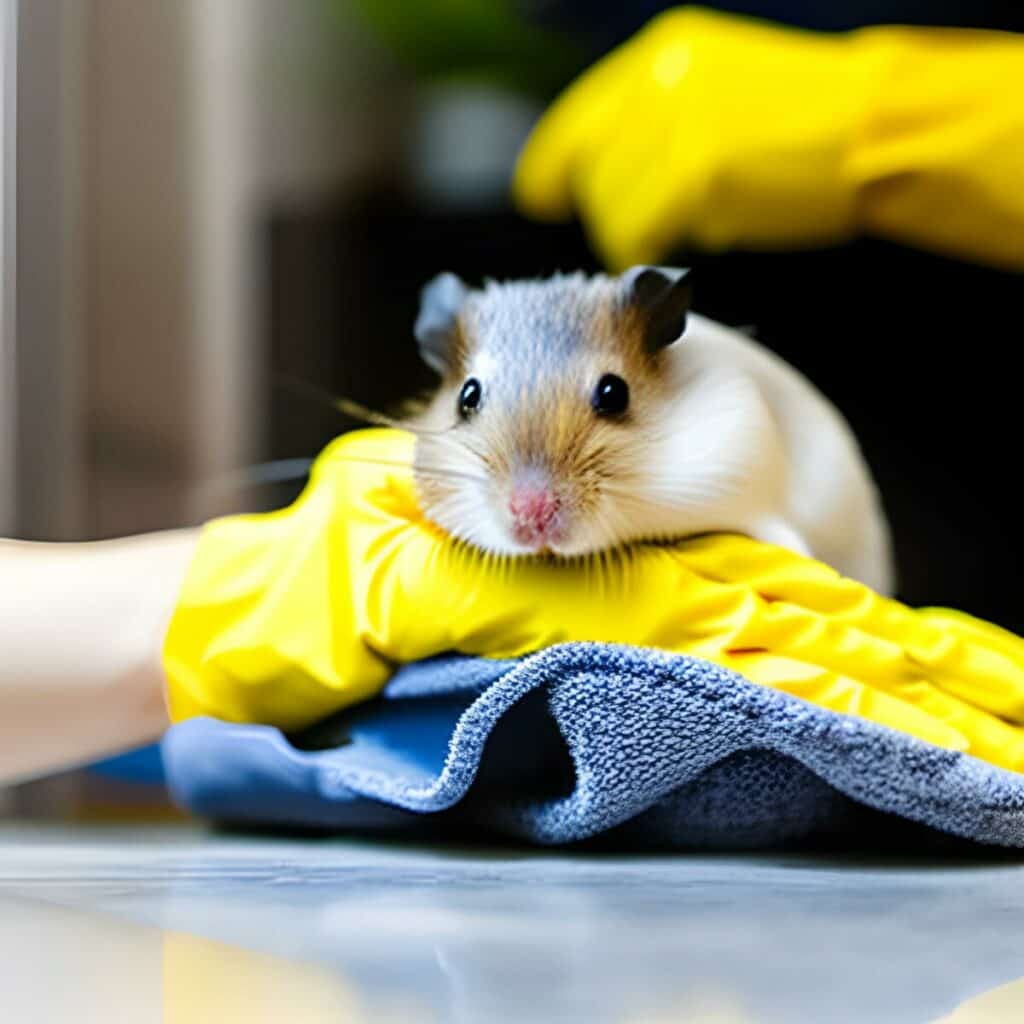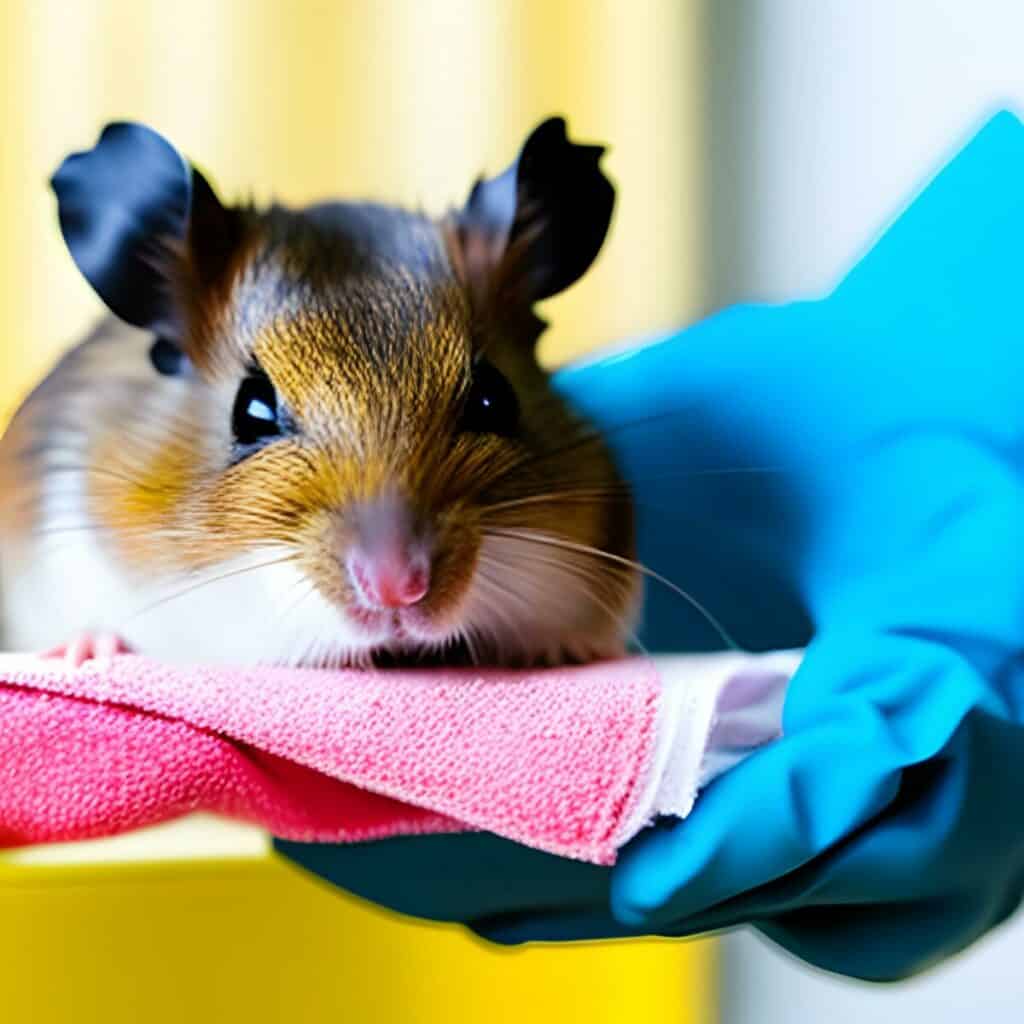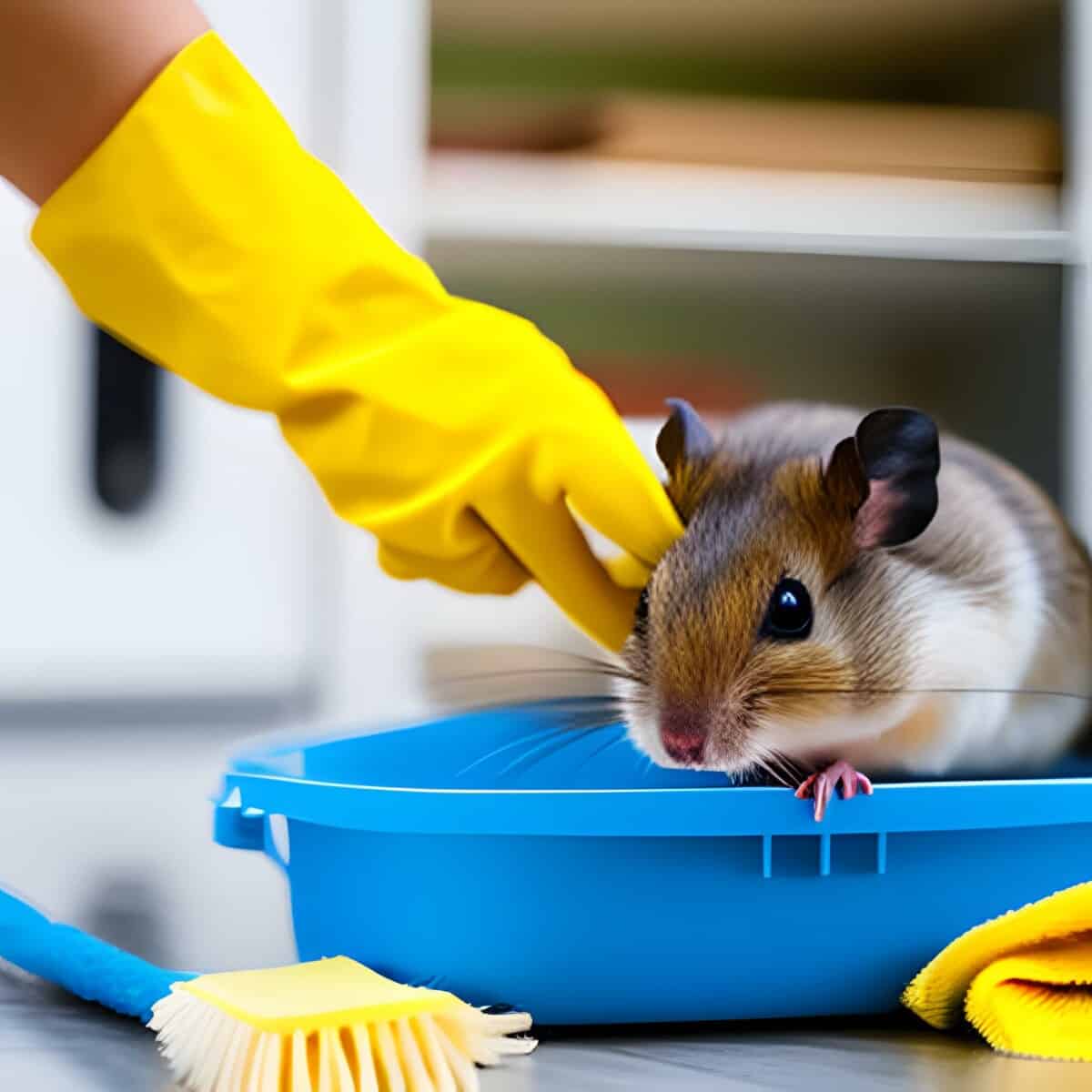Hamsters are famous for their immaculate grooming habits, but since we keep them as pets in cages or similar enclosures they occasionally need some additional bubbles to stay sparkly clean.
Vets can recommend hamster cleaning as part of supportive care in cases of skin irritations, mites, infection, or other reasons.
However, hamster bathing shouldn’t be a ritual and we don’t recommend it unless absolutely necessary or advised by the veterinarian.
By saying this we will still teach you how to clean a hamster, and we will cover the health benefits of doing so.
Let’s dive in.
How to Clean A Hamster: Table of Contents
1. Pick the right place and time
The best time to clean your hamster is during the day when they are awake and active.
This way, they will be less stressed and more cooperative during the cleaning process.
Find a well-lit room that is comfortable for both you and your hamster.
Make sure the surface you will use for hamster grooming is covered with a protective cloth or towel to avoid messes.
2. Gather Necessary Supplies
Before you start cleaning your hamster, you need to make sure you have all the necessary supplies on hand.
These supplies include:
- Cage cleaner
- Water to damp the towel or cloth.
- Hamster shampoo: Choose a shampoo that is specifically formulated for hamsters to avoid irritating their skin.
- Hamster towel: A soft and absorbent towel will help you dry your hamster after cleaning.
- Clean bedding: After cleaning the cage, you will need to replace the bedding with fresh and clean ones.
3. Handle your hamster gently

Hamsters can be timid and scared when handled, especially during cleaning.
To avoid scaring them, always approach them with a gentle touch.
You can hold your hamster by placing one hand over their back and the other hand under their belly. This way, they will feel supported and secure.
If they start to squirm or show signs of distress, it’s best to stop and give them a break.
Remember, your hamster’s safety and comfort should always come first.
4. Remove Your Hamster from Its Cage
Start by gently placing your hamster in a secure, temporary resting place such as a small enclosed basket.
First, remove any toys and bedding from the cage before cleaning.
It is up to you if you are going to clean the cage before or after the bath.
5. Clean the Hamster’s Fur
Use hamster shampoo by applying a small amount of shampoo on a soft cloth or sponge.
Massage your hamster’s fur gently until all dirt and grime are removed.
Rinse your hamster carefully with a cloth damped with lukewarm water, avoiding their face, eyes, and ears. Do not submerge your hamster in water.
6. Check for Any Health Issues
Check your hamster for any lumps, cuts, or sores after cleaning. Pet their fur carefully while checking for any unusual bumps. If there are any unusual bumps, it’s crucial to schedule a visit to the vet as soon as possible.
7. Dry Your Hamster

To dry your hamster, gently pat them with a clean, dry towel until they are dry.
Gently rub their fur to avoid any matting. Avoid using a hairdryer to dry your hamster, as this can be stressful and harmful to them.
8. Return Your Hamster to Its Clean Cage
Refill the bedding in the clean cage and return your hamster to its safe home.
How to clean a hamster cage
Remove all old bedding and replace it with fresh, clean bedding.
Hamsters can make a mess of their cage by emptying their food bowls, scattering their bedding everywhere, and playing in their water.
Clean Food and Water Containers
Clean your hamster’s food and water container regularly to remove any bacteria or mold. Hamsters can be prone to infection if they consume contaminated food or water.
Always sterilize food and water containers after use, ensuring to wash them thoroughly with warm water and soap.
Disinfect Cage and Accessories
Choose a pet-safe disinfectant and follow the manufacturer’s instructions. It’s crucial to ensure your hamster’s living space is disinfected properly, avoiding any toxic chemicals and rinsing with water after use.
Read our guide on How to Clean a Hamster Cage for details.
How often should you clean your hamster?
Hamsters have sensitive skin, and frequent bathing can disrupt the natural balance of their skin oils, leading to dryness, skin irritation, and even potential health issues.
Therefore, it is generally advised not to bathe hamsters unless specifically instructed by a veterinarian for medical reasons, such as treating a specific skin condition, skin sores and similar skin issues.
In their natural habitat, hamsters reside in arid environments and have evolved to maintain their cleanliness through self-grooming.
Instead of bathing, you can support your hamster’s grooming habits by providing them with a dust bath.
A dust bath consists of a shallow container filled with hamster-safe dust, such as chinchilla dust or fine sand. This allows your hamster to roll around and clean their fur naturally, removing excess oils and debris.
Health Benefits of Hamster Cleaning

Just like any animal, hamsters need to be cleaned regularly to prevent health issues.
A dirty hamster can be prone to diseases, infections, and skin irritation.
These health issues can lead to discomfort, pain, and even death in extreme cases.
Preventing Odor and Mess
Hamsters are cute, but they can also be messy. They love to chew on things and make a mess with their food and bedding.
Their cage and bedding can lead to unpleasant smells, dirty living conditions, and can attract unwanted guests such as mites and flies.
Regular cleaning of your hamster’s cage and bedding helps to keep your home odor-free and tidy. You can use a mild detergent to clean the cage and bedding, or you can replace them entirely.
Keeping your hamster’s living space clean will also make it easier for you to bond with your furry friend and enjoy their company.
Maintaining a Happy and Comfortable Environment
A clean living space and a healthy hamster translate to a happy and confident furry companion. When your hamster is happy and comfortable, they will be more playful, active, and fun to be around.
A dirty living space can be stressful for your hamster and can lead to behavioral issues such as biting and aggression.
Vet Q&A
Q: Can a bath kill a hamster?
A: Hamsters are highly sensitive to changes in temperature and stress levels, and submerging them in water can cause shock or even death. So, when the bath is recommended follow vet instructions exactly.
Q: Can I wash my hamster with water?
A: Spot cleaning is a preferred approach, where you can use hamster wipes or a damp cloth to gently clean specific areas of your hamster’s fur. This method allows you to address specific cleanliness concerns without subjecting your hamster to the potential dangers of a full water bath.
My Senior Paws is a participant in the Amazon Services LLC Associates Program, an affiliate advertising program designed to provide a means for sites to earn advertising fees by advertising and linking to Amazon.com. We also participate in other affiliate programs which compensate us for referring traffic.




